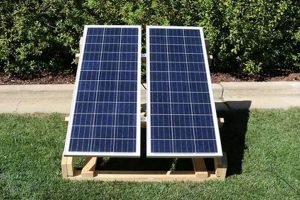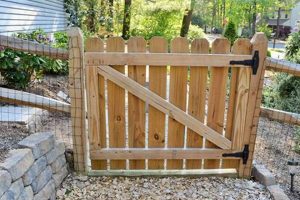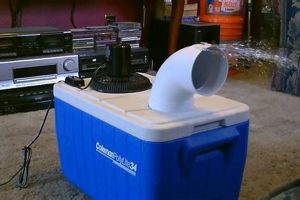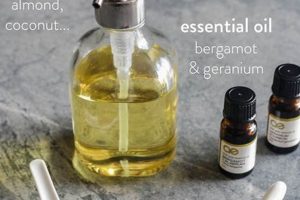A self-assembled cold water immersion vessel allows individuals to experience the therapeutic benefits of deliberate cold exposure in a personalized and potentially cost-effective manner. This approach contrasts with commercially manufactured units, offering greater control over design, materials, and overall investment. For instance, an individual might repurpose a stock tank or construct a wooden container, integrating a chilling unit for temperature regulation.
The practice of cold water immersion has been linked to various physiological and psychological advantages. Research suggests potential benefits in reducing inflammation, improving cardiovascular health, and enhancing mental resilience. Historically, cold water therapy has been employed in diverse cultures for its perceived revitalizing and healing properties, evolving from natural springs and icy rivers to controlled, constructed environments.
The subsequent discussion will delve into the key considerations for constructing a suitable system, including material selection, insulation techniques, water sanitation methods, and temperature regulation options. Safe implementation and maintenance practices will also be addressed.
Construction and Maintenance Tips
Successful implementation of a self-assembled cold water immersion system necessitates careful planning and execution. The following tips provide guidance on essential aspects of construction and ongoing maintenance, promoting longevity and safe operation.
Tip 1: Material Selection: Opt for non-toxic, durable materials resistant to water damage and temperature fluctuations. Polyethylene plastic, cedar wood, or stainless steel are viable options. Consider the long-term impact of material choice on water quality and structural integrity.
Tip 2: Insulation is Critical: Proper insulation minimizes energy consumption for cooling and maintains desired water temperature. Closed-cell foam insulation applied to the exterior of the vessel reduces heat transfer and improves efficiency.
Tip 3: Water Sanitation Protocols: Implement a consistent water sanitation routine to prevent bacterial growth and maintain hygiene. Ozone generators, UV sterilizers, or chemical sanitizers (following manufacturer instructions meticulously) are effective methods.
Tip 4: Temperature Regulation Systems: Explore various temperature control options, including submersible chillers, aquarium coolers, or repurposed refrigeration units. Select a system with adequate cooling capacity for the vessel’s volume and ambient temperature.
Tip 5: Filtration Matters: Install a filtration system to remove debris and particulate matter, extending water lifespan and improving clarity. Regular filter replacement is crucial for optimal performance.
Tip 6: Safety First: Always prioritize safety by implementing a GFCI (Ground Fault Circuit Interrupter) outlet for all electrical components. Monitor water temperature regularly to avoid hypothermia. Gradual acclimation is recommended for new users.
Tip 7: Regular Inspection and Maintenance: Periodically inspect the vessel for leaks, cracks, or signs of deterioration. Promptly address any issues to prevent further damage and ensure continued functionality. Proper maintenance is key to maximizing the lifespan of the system.
Adhering to these guidelines contributes significantly to the creation of a functional and safe self-assembled cold water immersion system, allowing users to fully leverage its potential benefits.
The subsequent section will address potential challenges and troubleshooting techniques associated with these systems.
1. Material Durability
Material durability is a primary determinant of the lifespan and safety of a self-constructed cold water immersion vessel. The materials selected for its construction directly impact its resistance to environmental factors, including prolonged exposure to water, temperature fluctuations, and potential physical stress. Inferior materials are prone to degradation, leading to leaks, structural failure, and the release of potentially harmful substances into the water, thereby compromising the user’s health and the system’s functionality.
For instance, using untreated wood can lead to rot and bacterial growth, requiring frequent repairs and potentially rendering the entire system unusable. Conversely, utilizing food-grade, high-density polyethylene (HDPE) offers superior resistance to chemical degradation and physical stress, significantly extending the lifespan of the vessel. Similarly, stainless steel offers excellent durability and resistance to corrosion, making it suitable for certain components of the system. The selection of materials therefore necessitates careful consideration of their inherent properties and their compatibility with the intended application.
In conclusion, prioritizing material durability in the construction phase is a critical investment that contributes directly to the long-term viability and safety of the self-assembled cold water immersion system. Neglecting this aspect can lead to costly repairs, potential health hazards, and a reduced lifespan for the apparatus, thereby negating the intended cost savings and health benefits. The selection process must consider all potential stressors and ensure the materials can withstand prolonged exposure without compromising structural integrity or water quality.
2. Temperature Control
Temperature control is a crucial element in a self-constructed cold water immersion system. Precise regulation of water temperature directly influences the physiological effects experienced during immersion. Insufficient temperature control renders the process less effective, potentially negating intended therapeutic benefits. Conversely, failure to maintain safe temperature ranges poses a risk of hypothermia, a condition involving a dangerous drop in body temperature. Therefore, reliable temperature control systems are essential for safe and effective operation.
Consider the example of an individual using a repurposed chest freezer as the immersion vessel. Without a dedicated temperature controller, the freezer’s inherent thermostat might not maintain the desired temperature range accurately. This can lead to significant temperature fluctuations, potentially compromising the intended physiological response. Implementing a digital temperature controller, however, provides precise regulation, allowing the user to maintain a consistent and safe temperature. Furthermore, systems using ice for cooling require careful monitoring, as ice melt rates vary, resulting in unpredictable temperature changes if left unmanaged.
In summary, accurate and reliable temperature control is not merely a desirable feature but a necessity for the safe and effective utilization of a self-assembled cold water immersion unit. Effective temperature control systems mitigate the risks associated with
inconsistent or extreme temperatures, allowing users to experience the potential benefits of cold water immersion in a controlled and safe environment. The design and implementation of temperature control systems require careful consideration of factors such as cooling capacity, control precision, and safety mechanisms to ensure optimal operation.
3. Water Sanitation
Maintaining adequate water sanitation within a self-assembled cold water immersion system is paramount to prevent the proliferation of harmful microorganisms and ensure user safety. Given that these systems often involve repeated use of the same water, effective sanitation protocols are essential to mitigate the risk of infection and maintain water quality.
- Bacterial Contamination Mitigation
Without proper sanitation, bacteria such as Pseudomonas aeruginosa and Legionella pneumophila can thrive in immersion systems, leading to skin infections, respiratory illnesses, and other health problems. Regular disinfection with appropriate chemicals or UV sterilization is necessary to kill or inactivate these pathogens. The choice of disinfectant should consider factors such as its effectiveness against a broad spectrum of microorganisms, its compatibility with the materials used in the system, and its potential for creating harmful byproducts.
- Algae Growth Prevention
Algae can flourish in immersion systems exposed to sunlight, leading to discolored water, unpleasant odors, and the potential for clogged filters. Covering the tub when not in use and using algaecides can help to control algae growth. Regular cleaning of the tub’s surfaces is also important to remove any accumulated algae biofilm. Furthermore, maintaining proper water chemistry, such as pH levels, can inhibit algae growth.
- Filtration System Integration
Filtration systems are essential for removing particulate matter, debris, and organic contaminants from the water, improving its clarity and reducing the burden on disinfection systems. Cartridge filters, sand filters, or diatomaceous earth filters can be used, depending on the size and type of contaminants being removed. Regular backwashing or replacement of filter elements is necessary to maintain their effectiveness.
- Sanitation Method Selection
Various sanitation methods are available for cold water immersion systems, each with its own advantages and disadvantages. Chemical sanitizers, such as chlorine or bromine, are effective at killing microorganisms but can cause skin irritation or produce harmful byproducts if not used properly. UV sterilizers are effective at inactivating microorganisms without adding chemicals to the water but require regular maintenance and may not be effective against all types of pathogens. Ozone generators are another option, but they can be expensive and require careful monitoring to avoid exceeding safe ozone levels.
In conclusion, rigorous water sanitation is indispensable for maintaining a safe and functional self-assembled cold water immersion system. Failure to implement effective sanitation protocols can lead to significant health risks and compromise the integrity of the system. The selection of appropriate sanitation methods and the establishment of a consistent maintenance schedule are crucial for ensuring the long-term viability and safety of these systems.
4. Insulation Efficiency
Insulation efficiency is a critical determinant of performance and operational cost in any self-constructed cold water immersion system. Its primary function is to minimize heat transfer between the cold water within the tub and the warmer ambient environment. Inadequate insulation results in accelerated warming of the water, necessitating more frequent cooling interventions and higher energy consumption. The practical consequence is a less consistent therapeutic experience and increased operational expenditure. Consider, for example, a system constructed without insulation in a warm climate; the water temperature could rise several degrees within a few hours, requiring constant chiller operation or frequent ice additions to maintain the desired cold. This contrasts with a well-insulated system, where temperature fluctuations are minimized, reducing the cooling load and maintaining a stable immersion environment.
Efficient insulation involves selecting materials with low thermal conductivity and applying them effectively to all exposed surfaces of the immersion vessel. Closed-cell foam insulation, for instance, offers superior thermal resistance compared to open-cell alternatives and is less susceptible to water absorption. Proper application includes ensuring complete coverage, sealing all seams and joints, and minimizing thermal bridging. Neglecting these details compromises the overall insulation effectiveness. A real-world example would be a DIY tub using rigid foam insulation but failing to seal the seams; air gaps create pathways for heat transfer, diminishing the insulation’s intended performance and negating potential energy savings.
In conclusion, insulation efficiency represents a fundamental aspect of self-constructed cold water immersion systems, impacting both operational cost and the stability of the cold exposure environment. The selection of appropriate insulation materials and meticulous application techniques are essential for maximizing energy savings, minimizing temperature fluctuations, and ensuring a consistent and therapeutic immersion experience. Effective insulation is not merely an optional addition but a necessary component for creating a functional and sustainable system. Further research on advanced insulation techniques may lead to more efficient and cost-effective DIY cold plunge solutions.
5. Structural Integrity
Structural integrity is a foundational requirement for any self-assembled cold water immersion system. The capacity of the enclosure to withstand the stresses imposed by the contained water volume, user weight, and environmental factors directly affects its safety and longevity. Compromised structural integrity can lead to catastrophic failure, potentially causing injury and significant property damage. Therefore, careful consideration of design, materials, and construction techniques is paramount.
- Load-Bearing Capacity and Water Volume
The fundamental aspect of structural integrity lies in the ability of the enclosure to support the hydrostatic pressure exerted by the contained water. A cubic meter of water weighs approximately one metric ton. Thus, a typical immersion tub holding 500 liters imposes a significant load. The base, walls, and supporting structure must be designed to withstand this weight without deformation or failure. An example of failure would be using thin, unsupported plastic sheeting, which would buckle and eventually rupture under the load.
- Material Selection and Joint Strength
The choice of materials directly influences the structural performance of the immersion system. Wood, for instance, requires proper sealing and reinforcement to prevent water damage and maintain structural integrity. Improperly sealed wood can rot, weakening the stru
cture and potentially leading to collapse. Similarly, the joints between different sections must be strong enough to withstand the applied forces. Weak joints, such as those made with insufficient adhesive or inadequate fasteners, can fail under stress, compromising the entire structure. - Environmental Considerations and Degradation
Environmental factors such as temperature fluctuations, UV exposure, and humidity can contribute to material degradation over time, weakening the structure. Wood can warp and crack, plastics can become brittle, and metals can corrode. Proper selection of materials resistant to these effects and the application of protective coatings are essential for maintaining structural integrity over the long term. For example, leaving an unsealed wooden tub exposed to direct sunlight and moisture will accelerate its deterioration.
- Reinforcement and Support Systems
Reinforcement and support systems play a crucial role in distributing the load and preventing localized stress concentrations. External supports, such as frames or braces, can provide additional stability and prevent deformation of the enclosure walls. Internal reinforcement, such as metal bands or fiberglass layers, can increase the strength and stiffness of the materials used in construction. Neglecting these systems can lead to premature failure, especially in larger immersion systems.
The preceding considerations demonstrate the multifaceted nature of structural integrity in the context of self-assembled cold water immersion units. A holistic approach encompassing careful design, material selection, robust construction techniques, and environmental protection is imperative to ensure a safe, functional, and durable system. Compromising on structural integrity can have severe consequences, undermining the intended benefits and posing significant risks to the user.
6. Safety Measures
The construction and utilization of a self-assembled cold water immersion system necessitate strict adherence to established safety measures. Neglecting these precautions introduces significant risks, potentially transforming a therapeutic practice into a hazardous undertaking. The connection between safety and construction is thus causal: the absence of safety protocols directly leads to increased potential for injury or adverse health outcomes. Without grounding electrical components, for instance, the presence of water creates a severe electrocution hazard. Similarly, failing to implement temperature monitoring mechanisms can result in hypothermia, a potentially life-threatening condition. Safety measures are, therefore, not ancillary additions but intrinsic components of any self-built immersion system.
Practical application of safety principles involves several critical steps. First, all electrical components, including pumps and chillers, must be connected to a Ground Fault Circuit Interrupter (GFCI) outlet to mitigate the risk of electric shock. Second, a reliable thermometer is essential to monitor water temperature consistently and prevent hypothermia. Third, users should gradually acclimate to the cold water, limiting initial immersion times and heeding their body’s signals. Furthermore, proper sanitation protocols minimize the risk of infection from waterborne pathogens. Real-world examples of safety negligence abound, ranging from individuals experiencing cardiac arrest due to sudden immersion in extremely cold water to electrocution incidents resulting from faulty wiring. The implications are clear: a failure to prioritize safety can have dire consequences.
In summary, the integration of comprehensive safety measures is non-negotiable for those undertaking the construction of a self-assembled cold water immersion unit. The potential for harm is substantial without rigorous adherence to safety protocols, rendering the pursuit of therapeutic benefits a perilous endeavor. Prioritization of GFCI protection, temperature monitoring, gradual acclimation, and stringent sanitation are essential elements in mitigating risks and ensuring a safe and beneficial immersion experience. The lack of vigilance can lead to injuries that outweigh any intended health benefits.
7. Maintenance Schedule
A meticulously planned and consistently executed maintenance schedule forms an indispensable component of any functional self-assembled cold water immersion system. The correlation between a lack of diligent maintenance and compromised system performance is direct and demonstrable. Without a defined schedule encompassing tasks such as water sanitation, filter replacement, and structural inspection, the system’s operational lifespan is significantly curtailed, and the risk of health hazards escalates. The consistent application of a well-structured schedule is therefore not merely a beneficial practice but a necessary precondition for the safe and effective long-term operation of such a system. For example, neglecting filter replacement can lead to reduced water clarity and increased bacterial load, negating the intended health benefits.
Practical implications of a properly implemented maintenance schedule are multifaceted. Regular water testing and adjustment of chemical balance, performed according to a predetermined timeline, prevent the growth of harmful microorganisms and maintain water quality suitable for immersion. Periodic inspection of structural components, such as seals and supports, allows for early detection and remediation of potential issues, preventing catastrophic failures and ensuring user safety. Cleaning protocols, addressing biofilm and mineral buildup, further extend the lifespan of the system and maintain its aesthetic appeal. Consider a scenario where a DIY system’s plumbing develops a minor leak. Early detection through scheduled inspection and prompt repair prevents further damage and potential water wastage, saving time and resources in the long run.
In summary, the maintenance schedule is inextricably linked to the overall performance and safety of a do-it-yourself cold plunge tub. Failure to adhere to a defined schedule leads to predictable consequences, including compromised water quality, structural degradation, and potential health risks. By prioritizing the establishment and consistent execution of a comprehensive maintenance regimen, users can maximize the lifespan, safety, and therapeutic value of their self-assembled cold water immersion system. Challenges may arise in adhering to a strict schedule, but the benefits far outweigh the effort involved. Proper maintenance transforms the construction project from a short-term endeavor into a reliable and sustainable practice.
Frequently Asked Questions
The following section addresses common inquiries concerning the construction, operation, and maintenance of self-assembled cold water immersion systems. These answers aim to provide clarity and guidance to individuals considering or currently utilizing this approach.
Question 1: What constitutes the minimum safe water temperature for a cold plunge?
The minimum safe water temperature is subjective and dependent on individual tolerance, health status, and immersion duration. However, prolonged exposure to temperatures below 40F (4.4C) carries a significant risk of hypothermia. Careful monitoring of body temperature and limited immersion times are crucial.
Question 2: What are the essential safety precautions when using a DIY cold
plunge tub?
Essential safety precautions include the use of a Ground Fault Circuit Interrupter (GFCI) for all electrical components, constant water temperature monitoring, gradual acclimation to the cold, strict adherence to water sanitation protocols, and avoidance of unsupervised immersion.
Question 3: How frequently should the water in a DIY cold plunge tub be changed or sanitized?
The frequency of water changes or sanitation depends on usage patterns and the effectiveness of the chosen sanitation method. At a minimum, the water should be fully changed every one to two weeks, even with consistent sanitation practices. More frequent changes may be necessary with heavy usage or visible contamination.
Question 4: What materials are most suitable for constructing a DIY cold plunge tub?
Suitable materials include high-density polyethylene (HDPE), cedar wood (treated and sealed), and stainless steel. These materials offer durability, water resistance, and chemical inertness, minimizing the risk of contamination and structural failure.
Question 5: How can the water temperature in a DIY cold plunge tub be effectively regulated?
Effective temperature regulation can be achieved through the use of submersible chillers, aquarium coolers, or repurposed refrigeration units, coupled with a digital temperature controller. The cooling capacity of the chosen system should be appropriate for the volume of water and the ambient temperature.
Question 6: What are the potential health risks associated with cold water immersion, and how can they be mitigated?
Potential health risks include hypothermia, cardiac arrest, and respiratory distress. These risks can be mitigated by gradual acclimation, limiting immersion duration, constant temperature monitoring, avoidance of immersion when feeling unwell, and consultation with a healthcare professional prior to starting cold water immersion practices.
These FAQs emphasize the importance of safety, proper maintenance, and informed decision-making when engaging with self-assembled cold water immersion systems. It is essential to approach this practice with caution and a thorough understanding of the associated risks and benefits.
The following segment will explore potential challenges and troubleshooting strategies associated with these systems.
Conclusion
The preceding discussion has comprehensively examined the construction, maintenance, and safety considerations pertinent to the effective implementation of a diy cold plunge tub. Key aspects, including material selection, insulation techniques, water sanitation protocols, and temperature regulation systems, have been explored. The analysis underscores the necessity for meticulous planning, diligent execution, and unwavering adherence to established safety guidelines to mitigate potential risks and ensure optimal functionality.
The informed deployment of such a system requires careful deliberation, ongoing vigilance, and a commitment to responsible utilization. While offering the potential for personalized therapeutic benefits, the onus remains on the individual to prioritize safety and maintain a proactive approach to system maintenance. The ongoing evolution of materials science and engineering may further refine the design and performance of these systems, contributing to safer and more efficient methodologies for cold water immersion in the future.







